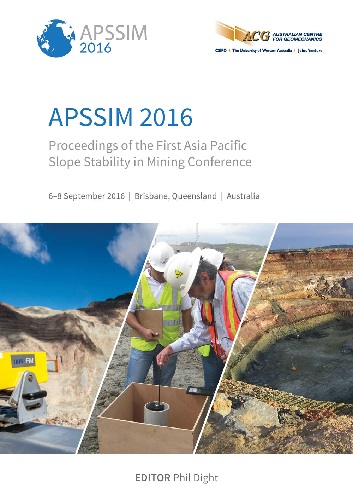Overall and bench slopes stability study using microseismic monitoring technique at Sandaozhuang open pit mine

|
Authors: Peng, F; Lin, F; Hu, J; Li, S; Cheng, J; Wang, C; Gao, J Paper is not available for download Contact Us |
DOI https://doi.org/10.36487/ACG_rep/1604_44_Peng
Cite As:
Peng, F, Lin, F, Hu, J, Li, S, Cheng, J, Wang, C & Gao, J 2016, 'Overall and bench slopes stability study using microseismic monitoring technique at Sandaozhuang open pit mine', in PM Dight (ed.), APSSIM 2016: Proceedings of the First Asia Pacific Slope Stability in Mining Conference, Australian Centre for Geomechanics, Perth, pp. 657-662, https://doi.org/10.36487/ACG_rep/1604_44_Peng
Abstract:
The Sandaozhuang open pit surface mine is a large molybdenum and tungsten mine, the geological reserves, of which, ranks it the highest in Asia and third in the world. Underground mining commenced in the 1960s, when the orebody was exploited without proper strategy. Open pit mining, owned by the China Molybdenum Co. Ltd, commenced in 2002, with current production capacity of 50,000t/d. A huge volume of known and unknown old underground workings exist under the overall and bench slope from early underground mining. The open voids are ~1,200,000 m² in area and ~18,000,000 m³ in volume, according to the available data. The mined out areas seriously affected the safety of equipment and personnel, and several bench and inter-bench slopes collapses have occurred over the years. Therefore, a 48-channel microseismic monitoring system was established in 2012, to carry out real-time monitoring of the slope stability. This study was to acquire rock mass wave velocity, attenuation coefficient and the Q-values through field testing of the characteristics of stress wave propagation in mined-out area and fractured rock masses. The testing results provided the basic parameters for sensor layout, source location optimisation and quantitative stability analysis of rock mass etc. By establishing a quantitative relationship between the peak particle velocity (PPV), the moment magnitude and the distance to source, the PPV value was calculated to assess the effect of blasting vibration on the stability of slope and underground mined out areas. The aggregation degree of localised microseismic events, the b value, and the energy index and apparent volume value were used to quantitative stability assessment of overall and bench slopes. At present, the microseismic monitoring technology has become an indispensable method in ground movement monitoring and geotechnical hazard management at the Sandaozhuang open pit mine.
Keywords: microseismic monitoring, stability of overall and bench slopes, characteristics of stress wave propagation, effect of blasting vibration
References:
Cheng, J & Peng, F 2013,‘Quantitative Analysis on the Stability of D Mining Area in Luomu Open-pit Mine Based on Microseismic Monitoring’, Mining Research And Development, vol. 33, no. 6, pp. 80–83.
Jihoon, H 2012, PPV-Magnitude-Distance Relationship: Need for a Site-Specific Calibration, Kingston, Canada.
Peng, F, Cheng, J, Jia, B, Lin, F & Li, S 2013, ‘Feasibility Study of Multi-channel Microseismic Monitoring at D Mining Area in Luomu Open-pit Mine’, Mining Technology, vol. 13, no. 1, pp. 33–36.
Peng, F, Li, S, Cheng, J & Jia, B 2014, ‘Experimental study on characteristics of stress wave propagation in mesoscale and complex rock mass by microseismic monitoring’, Chinese Journal of Geotechnical Engineering, vol. 36, no. 2, pp. 312–318.
Peng, F, lin, F, Hu, J, Chen, R, Li, X, Yang, S, Yu, W & Li, S 2015, ‘Indexes of mine microseismic and their application in safety assessment by statistical evaluation at Luomu mine’, in The 13th International Symposium on Rock Mechanics, Montreal.
Yao, Z & Ding, W 1995, ‘A Study on the characteristics of elastic wave dynamic parameters of rockmass damaged by earthquakes’, Journal of Lanzhou University(Natural Science), vol. 31, no. 3, pp. 113–118.
Zeng, Z, Ma, J & Liu, L 1995, ‘AE b-value dynamic features during rock mass fracturing and their significances’, Seismology and Geology, vol. 17, no. 1, pp. 7–11.
© Copyright 2025, Australian Centre for Geomechanics (ACG), The University of Western Australia. All rights reserved.
View copyright/legal information
Please direct any queries or error reports to repository-acg@uwa.edu.au
View copyright/legal information
Please direct any queries or error reports to repository-acg@uwa.edu.au